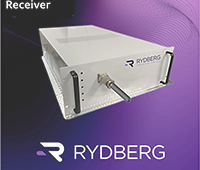Schematic drawing of a magnetic tunnel structure with a tunnel magneto thermoelectric voltage. A magnetic tunnel structure consists of two magnetic layers (red and blue) separated only by a thin insulation layer of approx. 1 nm (grey)—the so-called “tunnel barrier”. If a temperature difference delta-T is generated via the barrier, then the thermoelectric voltage VTh drops between the hot (red) layer and the cold (blue) layer. If the magnetic orientation, e.g. of the hot layer compared to that of the cold layer (arrows), is changed, this leads to a strong change in the measured thermoelectric voltage. (fig. by Schumacher/PTB) |
The
heat which occurs in tiny computer processors might soon be no longer
useless or even a problem. On the contrary: It could be used to switch
these processors more easily or to store data more efficiently.
These
are two of the several potential applications made possible by a
discovery made at the Physikalisch-Technische Bundesanstalt (PTB) in
Germany. This so-called “thermoelectronic voltage” may be
interesting—mainly for the use of nano-junctions, i.e. small components
based on magnetic tunnel structures. The results obtained by the
researchers have been published in the current issue of Physical Review Letters.
Today,
magnetic tunnel structures already occur in various areas of
information technology. They are used, for example, as magnetic storage
cells in non-volatile magnetic memory chips (the so-called
“MRAMs”—Magnetic Random Access Memories) or as highly sensitive magnetic
sensors to read out the data stored on hard disks. The new effect
discovered at PTB within the scope of a research collaboration with
Bielefeld University and the Singulus company could, in the future, add a
new application to the existing ones: monitoring and controlling
thermoelectric voltages and currents in highly integrated electronic
circuits.
Magnetic
tunnel structures consist of two magnetic layers separated only by a
thin insulation layer of approx. 1 nm—the so-called “tunnel barrier”.
The magnetic orientation of the two layers inside the tunnel structure
has a great influence on its electrical properties: if the magnetic
moments of the two layers are parallel to each other, the resistance is
low; if, on the contrary, they are opposed to each other, the resistance
is high. The change in the resistance when switching the magnetization
can amount to more than 100%. It is therefore possible to control the
electric current flowing through the magnetic tunnel structure
efficiently by simply switching the magnetization.
The
work carried out by the PTB researchers now shows that, besides the
electric current, also the thermal current flowing through the tunnel
structure can be influenced by switching the magnetization. In their
experiments, the scientists generated a temperature difference between
the two magnetic layers and investigated the electric voltage (the
so-called “thermoelectric voltage”) generated hereby. It turned out that
the thermoelectric voltage depends on the magnetic orientation of the
two layers nearly as strongly as the electric resistance. By switching
the magnetization, it is therefore possible to control the
thermoelectric voltage and, ultimately, also the thermal current flowing
through the specimen.
In
future, this new effect could be applied, for example, by using and
converting the energy of waste heat occurring in integrated circuits in a
targeted way. Furthermore, the discovery of this so-called “tunnel
magneto thermoelectric voltage” is a milestone in the research field
“spin calorics”—a field developing at a fast pace—which is currently
promoted by the Deutsche Forschungsgemeinschaft (DFG) within the scope
of a large-scale, 6-year priority program.
Tunneling magneto power in magnetic tunnel junction nanopillars





